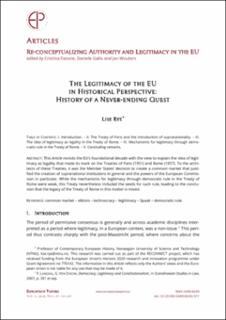| dc.contributor.author | Rye, Lise | |
| dc.date.accessioned | 2022-05-10T08:38:54Z | |
| dc.date.available | 2022-05-10T08:38:54Z | |
| dc.date.created | 2020-08-03T13:27:42Z | |
| dc.date.issued | 2020 | |
| dc.identifier.citation | European Papers (EP). 2020, 5 197-207. | en_US |
| dc.identifier.issn | 2499-8249 | |
| dc.identifier.uri | https://hdl.handle.net/11250/2994974 | |
| dc.description.abstract | This Article revisits the EU’s foundational decade with the view to explain the idea of legitimacy as legality that made its mark on the Treaties of Paris (1951) and Rome (1957). To the architects of these Treaties, it was the Member States’ decision to create a common market that justified the creation of supranational institutions in general and the powers of the European Commission in particular. While the mechanisms for legitimacy through democratic rule in the Treaty of Rome were weak, this Treaty nevertheless included the seeds for such rule, leading to the conclusion that the legacy of the Treaty of Rome in this matter is mixed. | en_US |
| dc.language.iso | eng | en_US |
| dc.publisher | Vincenzo Cannizzaro | en_US |
| dc.rights | Attribution-NonCommercial-NoDerivatives 4.0 Internasjonal | * |
| dc.rights.uri | http://creativecommons.org/licenses/by-nc-nd/4.0/deed.no | * |
| dc.title | The Legitimacy of the EU in Historical Perspective: History of a Never-ending Quest | en_US |
| dc.title.alternative | The Legitimacy of the EU in Historical Perspective: History of a Never-ending Quest | en_US |
| dc.type | Peer reviewed | en_US |
| dc.type | Journal article | en_US |
| dc.description.version | publishedVersion | en_US |
| dc.source.pagenumber | 197-207 | en_US |
| dc.source.volume | 5 | en_US |
| dc.source.journal | European Papers (EP) | en_US |
| dc.identifier.doi | 10.15166/2499-8249/377 | |
| dc.identifier.cristin | 1821339 | |
| cristin.ispublished | true | |
| cristin.fulltext | original | |
| cristin.qualitycode | 1 | |

